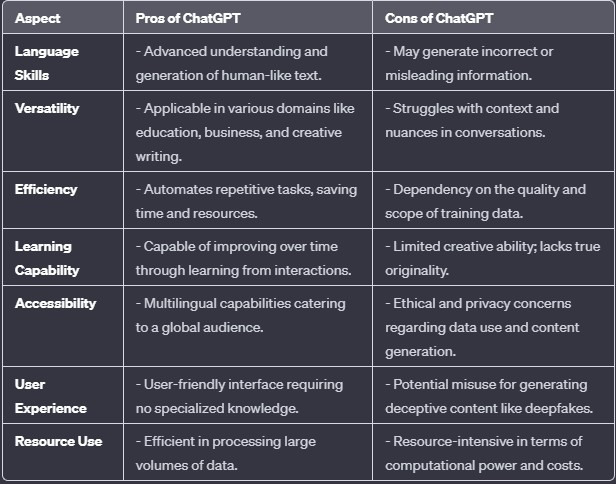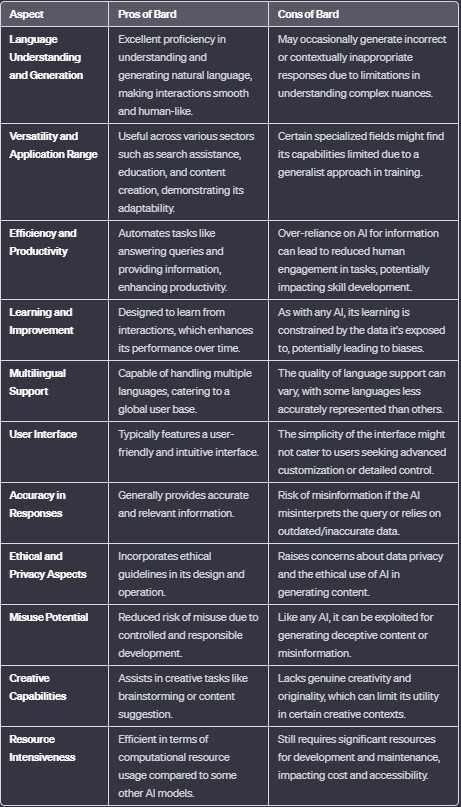
In the fast-evolving world of AI tools, two prominent names often emerge: Google Bard and OpenAI's ChatGPT. Both are generative AI models but serve different purposes and functionalities.
This blog post will explore these tools, highlighting the key differences to help you understand which might be better suited for your needs.
What is ChatGPT?
ChatGPT, developed by OpenAI, is a significant language model known for its advanced natural language processing capabilities. It can engage in human-like conversations, generate creative content, and assist with various language-based tasks.
ChatGPT has gained popularity for its versatility and the quality of its responses.
Pros and Cons of ChatGPT

ChatGPT presents a blend of advanced capabilities and challenges. While it's a powerful tool for language processing and automation, its limitations and potential risks, particularly in misinformation and ethical use, are important considerations for users and developers.
What is Bard?
Google Bard, on the other hand, is a generative AI model developed by Google. It leverages the power of Google's search engine and AI to provide up-to-date information and integrate with various Google apps.
Bard is designed to assist users in a more search-oriented manner, providing quick access to data across the web.
Pros and Cons of Bard

Bard vs. ChatGPT: What's the Difference?
Comparing ChatGPT and Google Bard involves understanding their origins, capabilities, and underlying technology. Here are the key differences between these two AI language models:
Developer and Technology Base
Bard
Developed by Google, Bard is presumed to be based on Google's significant strides in AI and natural language processing. It likely utilizes the capabilities of BERT (Bidirectional Encoder Representations from Transformers) and other proprietary AI models, harnessing Google's extensive research and development in machine learning and language understanding.
ChatGPT
Developed by OpenAI, ChatGPT is a sophisticated AI language model grounded in the Generative Pre-trained Transformer (GPT) series. Its evolution has seen significant advancements, with GPT-3 and the more recent GPT-4 showcasing remarkable improvements in understanding and generating human-like text.
These iterations offer enhanced natural language processing capabilities, making ChatGPT adept at a wide range of tasks, from conversational AI to complex content creation, setting new benchmarks in AI technology.
Core Functionality and Approach
Bard
Although shrouded in some mystery regarding its specific functionalities, Bard is anticipated to be woven into Google's renowned search technology. This integration suggests a strong focus on efficiently sourcing and displaying information.
It's likely to leverage Google's vast data and algorithms to provide rapid, accurate search results, potentially transforming how users access and interact with information online.
ChatGPT
ChatGPT specializes in producing text that resembles human communication, adeptly handling tasks such as simulating conversations, crafting various forms of content, and responding to diverse queries. Its ability to interpret input and generate relevant, coherent responses makes it invaluable for engaging in interactive dialogues, developing creative and informative content, and providing accurate answers to many questions.
Data Training and Learning Mechanism
Bard
Bard likely leverages Google's extensive dataset, encompassing web pages, books, and diverse online materials. This immense data pool allows it to grasp various subjects, offering comprehensive insights and understanding across numerous topics, reflecting Google's vast information repository.
This depth enhances Bard's capability to handle various queries.
ChatGPT
ChatGPT, trained on a vast spectrum of internet text, is adept at discussing many subjects. However, its knowledge is capped by the information available up to its most recent training update, making it less current on events or developments.
Integration with Other Technologies
Bard
Bard is anticipated to integrate seamlessly with Google's extensive range of products and services. This integration could significantly enhance the functionality of Google's search engine and various other applications, leveraging Google's vast data and technological capabilities to provide enriched, context-aware user experiences across its ecosystem.
ChatGPT
ChatGPT, despite its standalone capabilities, has seen widespread integration across diverse third-party applications and services, primarily facilitated by the availability of its API. This integration enhances the functionalities of these external platforms, leveraging ChatGPT's advanced language processing skills for varied use cases and user interactions.
Response Generation and Accuracy
Bard
Bard might possess a significant advantage in delivering search-optimized responses, leveraging Google's extensive experience and mastery in search algorithms and data indexing. This expertise enables Bard to efficiently parse vast amounts of information, ensuring highly relevant and accurate search results, thereby enhancing the user's experience in information retrieval tasks.
ChatGPT
ChatGPT, renowned for its engaging conversational style and in-depth responses, transcends mere information retrieval. Its versatility makes it ideal for diverse applications, including creative writing, educational tutoring, customer service, and interactive entertainment, revolutionizing how we interact with AI in numerous domains.
Multilingual Capabilities
Bard
As a Google creation, Bard is anticipated to excel in multilingual capabilities, leveraging Google's vast expertise in language translation and processing. This advantage stems from Google's comprehensive research and development in linguistic technology, ensuring effective communication across diverse languages and enhancing global accessibility.
ChatGPT
ChatGPT supports various languages, providing a broad reach in global communication. However, its proficiency levels differ across languages, primarily influenced by the extent and quality of training data available for each language.
This variation affects its accuracy and effectiveness in understanding and responding in non-English languages.
User Interface and Accessibility
Bard
While specific details about Bard's user interface remain under wraps, expectations are high for it to be user-friendly and easily accessible. This anticipation is based on Google's established design ethos, emphasizing intuitive design and straightforward navigation, ensuring users of varying technical backgrounds can engage with their technology effectively.
ChatGPT
ChatGPT's interface is renowned for its simplicity and intuitiveness, ensuring easy accessibility for users across various skill levels. This user-friendly design enables individuals with minimal technical expertise to navigate and utilize its advanced AI capabilities effectively, thereby democratizing the use of sophisticated language model technology.
Applications and Use Cases
Bard
Bard is anticipated to excel in swiftly and accurately retrieve information, making it ideal for search-related applications. Its integration with Google's extensive data and search technology expertise suggests a solid capability to efficiently source and present relevant information, enhancing user experience by quickly acquiring knowledge.
ChatGPT
ChatGPT's versatility extends across a wide array of applications. It excels in conversational AI, engaging in asked ChatGPT-like human-like dialogue, and is adept at content creation, aiding in crafting well-written text.
Its utility in educational contexts and coding assistance further showcases its multifaceted nature, making it invaluable in diverse fields.
Ethical Considerations and Limitations
Bard and ChatGPT face challenges regarding ethical considerations, data privacy, and the potential for misinformation or biases in their responses.
In conclusion, while both Bard and ChatGPT are advanced AI language models, their differences lie in their development background, core functionalities, integration with other technologies, and the specific applications they are optimized for. As these technologies evolve, their capabilities and use cases may also overlap.
Bard Vs. ChatGPT: Which To Choose Better?
Choosing between Bard and ChatGPT depends on several factors, including your specific needs, the context of use, and the particular strengths of each AI model. Here's a guideline to help you decide which might be better suited for your requirements:
Bard
When to Choose Bard:
Integration with Google's Ecosystem: If you heavily rely on Google's suite of products and services, Bard might offer seamless integration and enhanced functionality within that ecosystem.
Search-Optimized Responses: For tasks that require quick and efficient information retrieval, Bard, with Google search technology expertise, may excel.
Multilingual Support: Given Google's extensive work in language processing, Bard might be the better choice for applications requiring robust multilingual support.
Ideal for:
Users who prefer or require close integration with Google's products.
Scenarios where search engine capabilities are a priority.
Environments needing strong support for multiple languages.
ChatGPT
When to Choose ChatGPT:
Versatile Conversational AI: If you need an AI for a broad range of conversational tasks, from customer service to creative writing, ChatGPT's conversational abilities are highly advanced.
Content Creation and Assistance: For generating detailed, nuanced content or assistance in tasks like coding or writing, ChatGPT's abilities are well-suited.
Accessibility and Ease of Use: ChatGPT is generally user-friendly and accessible, making it suitable for those without extensive technical expertise.
Ideal for:
Businesses and individuals need a versatile conversational AI for various applications.
Content creators, educators, and developers are seeking an AI assistant.
Users seeking an AI tool that is straightforward to interact with.
Key Considerations:
Specific Requirements: Assess the particular tasks you need the AI for – whether it's information retrieval, conversation, content generation, etc.
Integration Needs: Consider which AI integrates better with your existing tools and workflows.
Ethical and Privacy Concerns: Evaluate how each platform aligns with your moral standards and privacy requirements.
Language Necessities: If multilingual capabilities are crucial, consider which AI offers better support in your required languages.
Cost and Accessibility: Check the availability and associated costs of using Bard or ChatGPT for your intended purpose.
Ultimately, the choice between Bard and ChatGPT should be based on which platform's strengths align more closely with your needs and objectives. Both have unique advantages and can be highly effective in the proper context.
Bottom Line
Both ChatGPT and Bard represent significant strides in AI technology. Despite being sophisticated large language models, a few key differences become apparent when comparing Google's Bard and ChatGPT.
Google Bard, as a part of the broader spectrum of generative AI tools, integrates deeply with Google's vast data and search technology, potentially offering a more search-oriented experience. ChatGPT, on the other hand, excels in producing human-like responses across various contexts, making it highly versatile in conversational AI applications.
How Bard and ChatGPT process and generate language indicates their distinct development paths and intended applications. While both Google Bard and ChatGPT represent significant advancements in AI, understanding their unique attributes and capabilities is crucial in determining the right tool for specific needs in the ever-evolving landscape of AI technology.
Subscribe for more AI updates now!
FAQs
Is it safe to use Google Bard?
Bard utilizes your location and previous dialogues to deliver optimal responses. As an experimental technology, Bard might occasionally produce incorrect or unsuitable information that needs to reflect Google's official views.
Can Bard and ChatGPT be used for professional purposes?
Yes, both can be used for various professional tasks, including content generation and data analysis.
Is there a free version of ChatGPT and Bard available?
ChatGPT does offer a free version, while Bard's accessibility might depend on Google's policy. Bard is accessible in over 40 languages and over 230 countries and territories; ChatGPT offers nine languages and is available in 164 countries and regions.
Is Google Bard like Siri?
Similar to Amazon's recently announced Alexa with generative AI, Assistant with Bard aims to provide a "more personalized helper" than the relatively simplistic smartphone assistants (including Alexa and Siri) we've grown accustomed to over the past decade.
Can Google Bard generate images?
Yes, Google Bard can generate images. Bard uses artificial intelligence algorithms to understand and generate textual output. Google is partnering with Adobe FireFly to add image generation to Bard.
